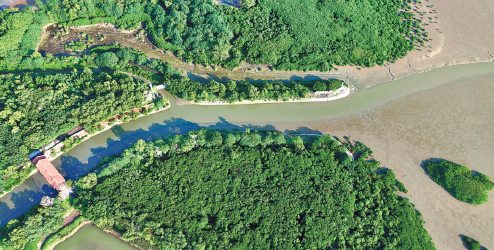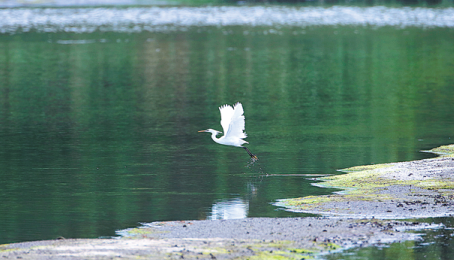Futian's nature reserve a key stop for migratory birds

Tens of thousands of migratory birds are flocking to Shenzhen, a subtropical metropolis in South China, from October to next March, making the city one of the most important stops for these birds in the Eastern Hemisphere.
They usually choose a State-level mangrove nature reserve in Futian district, the smallest of its kind in China and the only one located in an urban area, near one of its busiest avenues and less than a kilometer away from the bustling city.
The Futian Mangrove National Nature Reserve, coupled with the neighboring Mai Po Nature Reserve in Hong Kong, forms the Shenzhen Bay mangrove wetland ecosystem.
It has been in the limelight since China proposed building the world's first international mangrove center in Shenzhen during the 14th Meeting of the Conference of the Contracting Parties to the Ramsar Convention on Wetlands, which concluded in Wuhan, Hubei province on Sunday.
The management office of the reserve said staff there detected the first batch of six black-faced spoonbills, one of the most endangered species in the world, on Oct 10, followed by a group of more than 100 at the end of the month and another 50 in early November. These have been the largest numbers of the species spotted in Shenzhen so far.
One of them wears the band sign K34, a bird which has flown in from South Korea that has been seen three times, the management office said.
The census result released by the Hong Kong Bird Watching Society in April showed that the number of black-faced spoonbills reached 6,162 across the globe, up 18 percent year-on-year.
According to the management office of Futian's nature reserve, about 50 million waterfowl across 250 species will fly the Siberia-to-Australia route each year. Shenzhen has served as the middle leg for the birds as they stay through the winter or rest before moving on.
So far, the city's professional bird watchers have recorded around 200 species, including a dozen rare species, and that number has kept risen over the years.
Protection efforts
To create a better environment for the migratory birds, the reserve in Futian has protected and restored the wetlands to make it friendlier for the long-haul guests.
The mangroves in the reserve, covering an area of about 100 hectares, or nearly one-third of the city's total area of mangroves, together with the tidal-flat areas and fishponds provide sufficient food and ideal habitats for the birds.
The fishponds that used to raise shrimps have been adjusted since 2006. A lower water level and restricted growth of certain plants boosts the habitat for the birds, a report by the Southern Metropolis Daily said.
For example, reeds growing in the middle of the fishponds were removed because they would prevent the birds from landing, said the report.
This year, the management office of the reserve also broke barriers and connected several small fishponds and dug a ditch surrounding it so the environment is more favorable for the birds.
In terms of city construction, the district government of Futian paid attention to the protection of the environment and the migratory birds when planning a new innovation zone with Hong Kong along the boundary of a river, which is in the Shenzhen Bay ecosystem area.
It has lowered the height of buildings, increased roof greenery, cut urban light pollution and carried out annual surveys to evaluate the effect of urban construction over the ecosystem.
Coexisting harmoniously
The district of Futian, the hub of administration, culture, finance, commerce and international exchanges in Shenzhen, has demonstrated a way for people and nature to coexist.
Taking up just 4 percent of the total land area of Shenzhen, the district contributed nearly one-fifth of the city's GDP and one-fourth of its tax revenue.
The GDP of Futian rose 4.2 percent year-on-year to about 256 billion yuan ($36.3 billion) in the first half of the year, said the district statistics bureau.
It has about 50 skyscrapers with a height of more than 200 meters, including the tallest building of the city at nearly 600 meters, and has the most commercial facilities in Shenzhen. It also has the most parks: residents can walk no more than 500 meters to reach one.
"It is just what the literal meaning of Futian means. It's a happy land for me to live and work in. It has convenient transportation, good restaurants, happy hours at bars and camping time over the weekends," said Hui Xinhong, a media company employee.
Tian Suixing, vice-president of Shenzhen Bird Watching Society, has been watching birds for nearly 20 years. He spent most of his spare time around the mangroves in Futian during migration season. "It seems that natural splendid scenes unfold before me when I am watching the birds. I enjoy the moments very much."
chenhong@chinadaily.com.cn





















